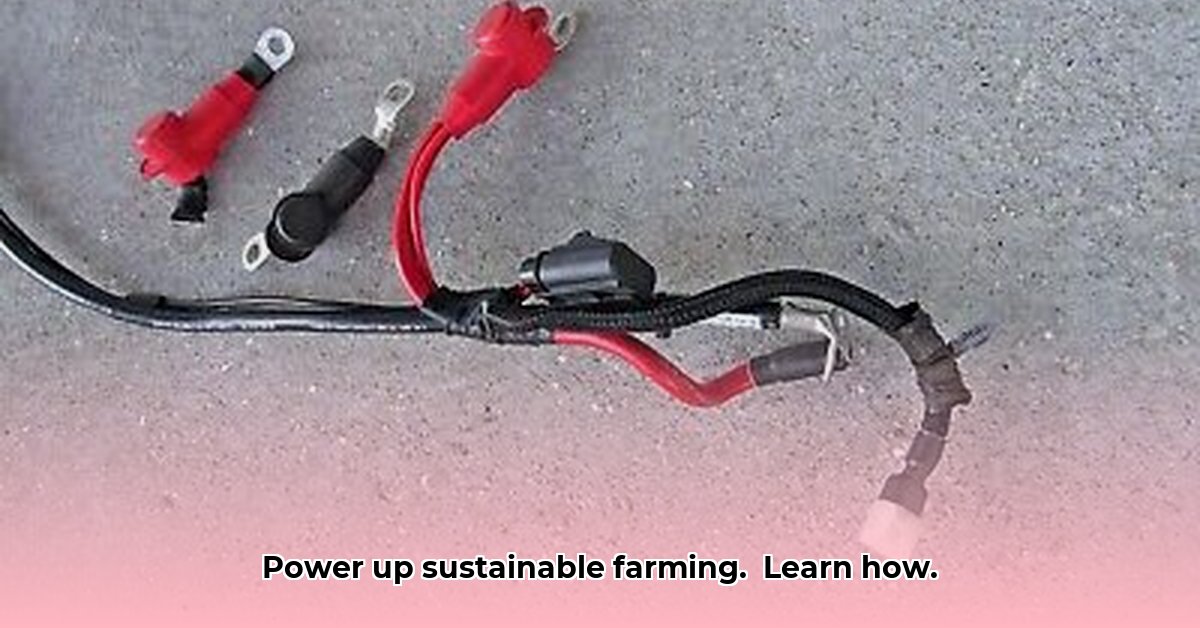
Choosing the right battery cables is critical for reliable and efficient farm operations. These cables, often overlooked, are the electrical lifelines of modern agricultural machinery, powering everything from tractors to irrigation systems. Investing in high-quality cables translates directly into increased productivity and reduced downtime. This article explores selecting, installing, and maintaining tractor supply battery cables for a sustainable farming operation. For more information on tractor supply options, check out this helpful resource: Tractor Supply Guide.
Understanding Your Farm's Power Requirements
Before purchasing battery cables, carefully assess your farm's electrical demands. The size and type of your equipment directly influence the cable's specifications. Larger machinery and higher-power demands necessitate thicker, more robust cables capable of handling significant electrical currents (amperage). Longer cable runs increase resistance, requiring thicker gauge wires to compensate for voltage drop. Tractor Supply offers a variety of gauges and lengths to accommodate diverse farming needs.
What amperage is required to power your largest piece of equipment? This consideration is paramount in selecting appropriately sized cables.
Deciphering Cable Gauge: A Crucial Specification
The gauge number stamped on the cable indicates its thickness; a lower gauge number represents a thicker cable. Thicker cables (lower gauge) carry more current with less resistance, minimizing heat buildup and reducing the risk of overheating or fire. This is a critical safety consideration. A 0 gauge cable will carry significantly more current than a 10 gauge cable.
Did you know that a 2 gauge cable can carry approximately twice the current of a 4 gauge cable? Understanding this relationship is essential for choosing appropriately sized cables.
Think of it like plumbing; a larger pipe facilitates greater water flow. Similarly, a thicker cable enables more efficient electrical current flow. Proper gauge selection is not just about performance but also about safety.
Cable Materials: Beyond Copper
Copper remains the industry standard for its conductivity and durability, although it's more expensive. Aluminum provides a more budget-friendly option, though its longevity and performance in extreme conditions might be slightly less robust. Tractor Supply offers a range of options, allowing farmers to balance cost and performance based on their specific demands.
"For less demanding applications, aluminum cables can be a cost-effective choice," says Dr. Anya Sharma, Agricultural Engineer, University of Nebraska-Lincoln. "However, copper remains superior in high-current applications, particularly in harsh environments."
Installation: Best Practices for Extended Cable Lifespan
Correct installation is crucial for both safety and longevity. Follow these steps:
Clean Connections: Thoroughly clean battery terminals and cable ends to remove corrosion using a wire brush and battery terminal cleaner. Corrosion acts as an insulator, hindering current flow.
Secure Tightening: Use appropriately sized bolts and washers to ensure the connections are exceptionally tight. Loose connections cause voltage drops, excessive heat, and potential fire hazards.
Strategic Routing: Route cables away from moving parts, sharp edges, and heat sources. Secure them with cable ties to prevent damage.
Protective Measures: Use protective sleeves or conduit, especially in exposed areas, to extend cable lifespan and protect against abrasion and the elements.
Regular Inspection: Regularly inspect cables for wear, corrosion, or damage. Address any issues promptly.
Maintenance: Prolonging Cable Lifespan
Regular maintenance is crucial cable longevity.
Clean Terminals Regularly: Clean battery terminals with a wire brush and terminal cleaner, potentially using an anti-corrosion protectant.
Frequent Inspections: Visually inspect cables monthly (more often during peak usage) for wear, cuts, or cracks.
Periodic Tightening: Periodically check and tighten all connections, particularly after heavy machinery use or extreme weather.
Prompt Replacement: Replace damaged cables immediately to avoid escalating problems.
The Value Proposition: Quality vs. Cost
The initial higher cost of high-quality cables is offset by their longer lifespan, reduced maintenance, and minimized downtime. Investing in quality cables from a reputable source reduces long-term costs and enhances safety.
Sustainable Practices: A Holistic Approach
Remember, battery cables are just one component of a farm's electrical system. A well-maintained battery and charging system are equally important. Integrating renewable energy sources for charging further enhances the sustainability of your farm's power solution.
How can solar power integration improve both the economic and ecological aspects of your farming operation? This question highlights the broader context of sustainable agricultural practices.